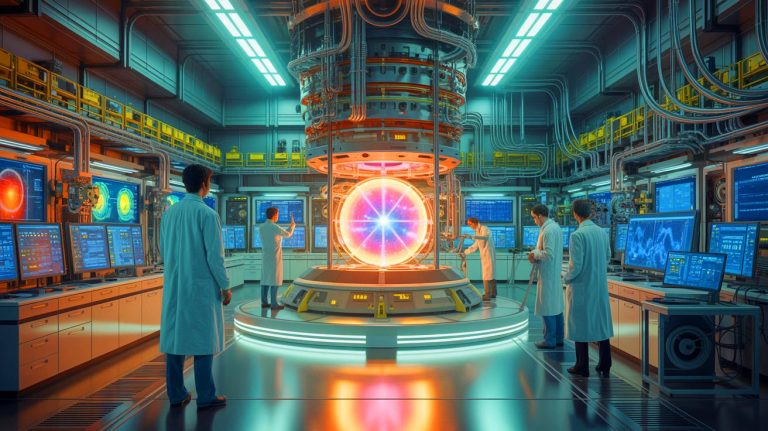| IN A NUTSHELL |
|
In the burgeoning field of nuclear fusion, the quest for a sustainable and safe energy source is a global effort, with numerous countries vying to make groundbreaking advancements. Recently, scientists in Switzerland have made a significant leap by discovering a method to efficiently remove excess heat from a tokamak, a type of fusion reactor. This discovery is crucial for ensuring the reactor’s safety during high-temperature operations. The Variable Configuration Tokamak (TCV) experiment at the Swiss Federal Institute of Technology in Lausanne (EPFL) has introduced a novel approach that could revolutionize how we manage heat in fusion reactors.
Enhancing Heat-Removing Radiation with the X-Point Target Radiator
At the heart of this innovation is the ability to enhance heat-removing radiation in the tokamak. Conducted by Kenneth Lee and his team at EPFL, the experiment involved the TCV, a facility known for its advanced capabilities in fusion research. The TCV’s unique design includes an X-point, a critical feature of modern tokamaks. This X-point serves as a passage for reaction by-products, allowing them to escape through a magnetic funnel known as a divertor. By introducing a second X-point along the divertor funnel, the researchers have found a way to boost the radiation that removes excess heat from the reactor.
This innovation, referred to as the X-point target radiator (XPTR), has shown promising results. It allows for better management of the heat produced during fusion reactions, thus protecting the reactor walls from potential damage caused by overheating. The XPTR concept is not only innovative but also practical, as it can be implemented in next-generation tokamak reactors like SPARC, being developed in collaboration with MIT.
Validation and Implementation of the Novel Concept
The experiments conducted at TCV have validated the XPTR concept, proving its effectiveness and ease of implementation. The conditions required to utilize the XPTR are straightforward, making it a feasible solution for future fusion reactors. This breakthrough aligns with the goals of projects like SPARC, which aim to develop advanced tokamak reactors capable of producing sustainable energy.
TCV, known as “Tokamak à Configuration Variable,” is a pivotal facility in Lausanne, focusing on the most sophisticated techniques for nuclear fusion. The tokamak design utilizes a doughnut-shaped magnetic field to confine hot plasma, enabling the production of high temperatures needed for fusion reactions. This setup is essential for achieving controlled fusion, a process where light atomic species, such as hydrogen, fuse to release energy. The promise of fusion power as an almost inexhaustible energy source for the future makes these advancements all the more critical.
Understanding the X-Point Radiator Concept
The new type of X-point radiator developed by Lee and his team offers significant advantages. The secondary X-point facilitates easier access to detachment and reduces the sensitivity of the radiative front’s position near it. This secondary X-point is strategically placed away from the confined plasma, enhancing the system’s efficiency.
From a theoretical standpoint, the origin of X-point radiation is attributed to its magnetic geometry. This characteristic is independent of whether the magnetic field lines are open or closed, making the concept robust and versatile. The findings suggest that novel power exhaust concepts can be developed, where radiative edge cooling can be effectively managed during divertor detachment. This advancement opens new avenues for developing fusion reactors that are both efficient and safe.
The Path Forward for Fusion Energy
The implications of these developments are profound, as they pave the way for more efficient fusion reactors that can safely operate at high temperatures. The ability to manage heat effectively is paramount for the success and longevity of fusion reactors. As the world seeks sustainable energy solutions, the innovations emerging from the TCV and similar experiments offer hope for a future where fusion power becomes a cornerstone of our energy infrastructure.
As researchers continue to refine these techniques, the potential for fusion energy to transform the global energy landscape becomes more tangible. Could these advancements lead to a new era where fusion power supplants traditional energy sources, ushering in an age of clean and virtually limitless energy?
Did you like it? 4.4/5 (30)










Wow, this sounds like a game-changer for fusion energy! 🚀
Can someone explain what an X-point is? I’m not familiar with the term.
Great work, EPFL team! This could really be the future of clean energy. 🌍
How soon can we expect to see these technologies in commercial reactors?
This is fascinating, but how does it compare to other heat management methods?
I’m skeptical. We’ve heard many fusion breakthroughs before. What’s different this time?
Are there any environmental concerns with using this new technology?
Does this mean cheaper electricity bills in the future? 🤔
How much do they cost? Cuz we can blow them up with a $900 drone.